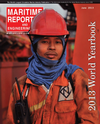
Page 24: of Maritime Reporter Magazine (June 2013)
Annual World Yearbook
Read this page in Pdf, Flash or Html5 edition of June 2013 Maritime Reporter Magazine
24 Maritime Reporter & Engineering News ? JUNE 2013 and Þ nancing a transshipment cargo port at Dutch Harbor in the Aleutians. In preparation, I gathered National Oceanic and Atmospheric Administra- tion (NOAA) charts and polar maps and read volumes of reports. Delega-tion members also made an inventory of Alaskan products for export and products being shipped between the Pa-ciÞ c and Atlantic via the Panama Canal. Also studied were statistics on products shipped from Europe to Asia via Suez Canal or around the Capes.In doing so, we came to believe the TASR offered an opportunity for the global shipping dynamic: vastly shorter distances offer shorter port-to-port tran- sit times that will potentially amount to hundreds of billions of dollars in reduced operating costs and saving to clients, not to mention reduced energy use, emis- sions as well as less exposure to disasters inherent on current routes. Weather and ice conditions do present formidable challenges. We also learned other Arctic nations had more focus on the Arctic than the U.S., and that Alaska had no authority to create or operate the TASR. Finland was building icebreak- ers and assisting Russia with the Shtok-manovskoye Gas Prospect in the Barents Sea. And as we grew familiar with the Shtokmanovskoye Project, we realized Alaska?s resources had commercial vol- umes of natural gas that could support creating necessary LNG conditioning, pipeline and loading facilities on the North Slope. Not to mention the poten-tial of exporting the Point Lay High-BTU, Low-Sulfer, low ash exportable ?clean? coal. We toured icebreakers, reviewed remote sensing technologies capable of providing real time analysis of ice conditions and we visited facili-ties that simulate ice conditions on ships. With all this enhanced knowledge, we became convinced of the technical abil-ity to construct purpose built ships (see attached student drawn SWATH concept drawing below) and loading facilities suited for the TASR. We envisioned a ?mirror? develop- ment to the Shtokmanovskoye project in Alaska. Instead of bringing natural gas onshore for conditioning and ship-ment south, Alaska?s natural gas (and high BTU, low sulfer coal) could be sent offshore three to Þ ve miles through a pipelines inside sub-surface tunnels to loading platform where purpose built Very-Large Ice-Classed LNG Ships could transport the gas to markets in Asia or Europe. We were con Þ dent of the Finnish shipbuilders experience and ability to build the ships.With this knowledge we returned to Alaska and presented the possibilities. Unfortunately, interest in exporting LNG via the TASR waned as then Gov- ernor Hickel left ofÞ ce and a new Envi- ronmental Industry backed anti-develop-ment administration took control. Fast forward 20 years and technology has advanced non-stop, from comput-ers and communication to LNG trans-portation and distribution. In maritime LNG transportation, Submerged Turret TRANS ARCTIC SHIPPING ROUTES Concept drawing of a purpose built SWATH for Arctic Ops. North Slope Oil Map MR #6 (18-25).indd 24MR #6 (18-25).indd 245/30/2013 12:09:18 PM5/30/2013 12:09:18 PM

 23
23

 25
25
